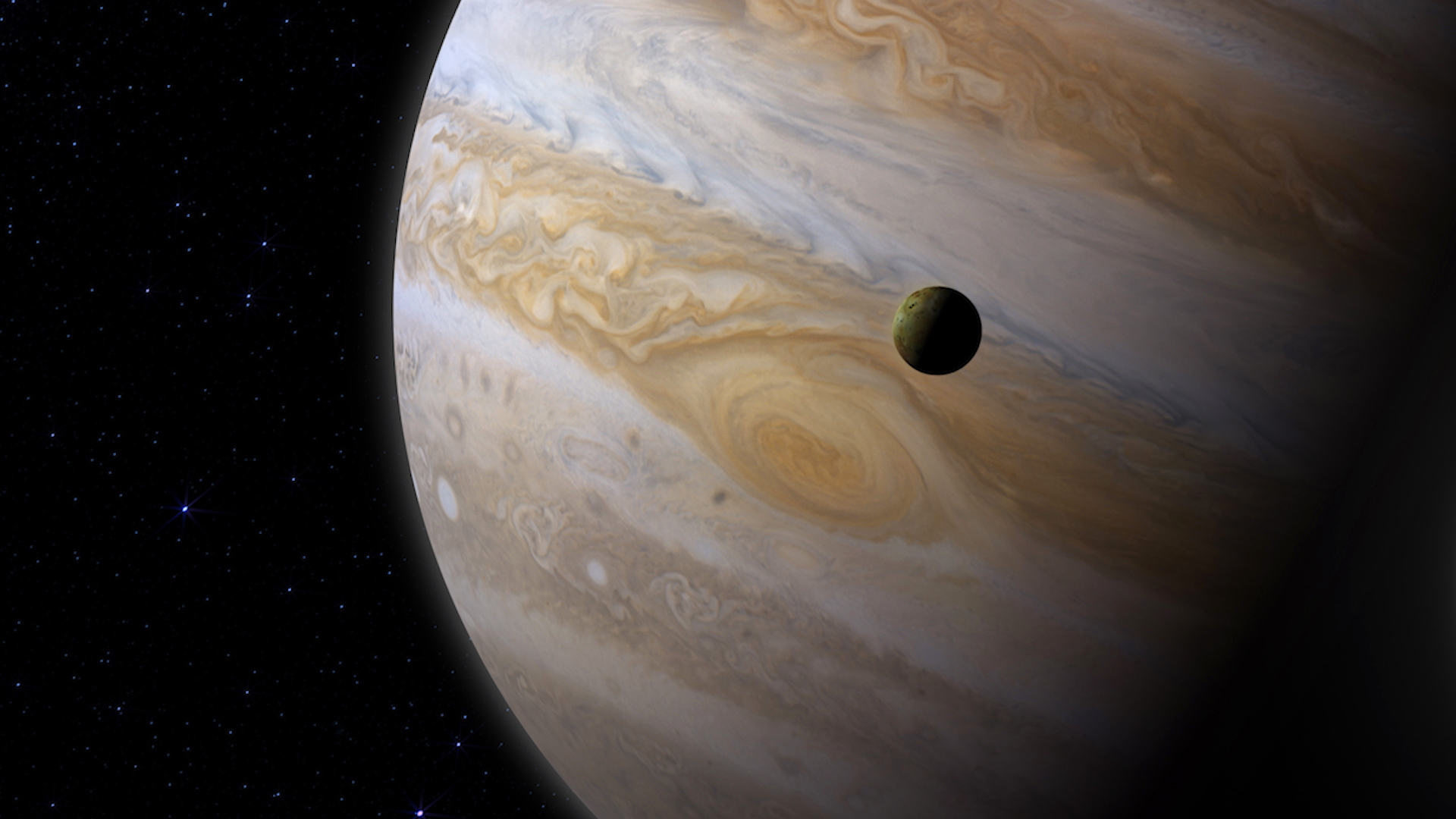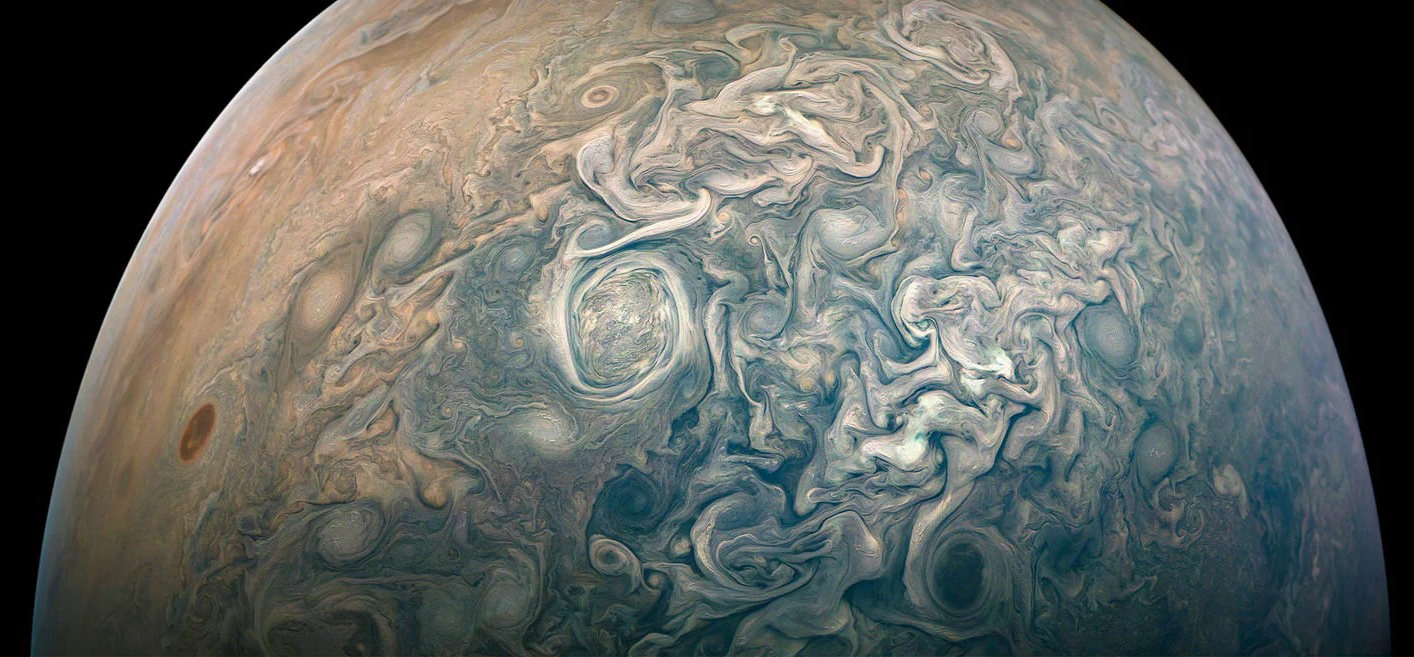What if Jupiter Was Supposed to Become a Star
Jupiter Is Bigger Than Some Stars, So Why Didn't Nosotros Get a 2nd Lord's day?
The smallest known main-sequence star in the Milky way galaxy is a real pixie of a thing.
It'south chosen EBLM J0555-57Ab, a red dwarf 600 light-years away. With a mean radius of effectually 59,000 kilometres, it's just a smidge bigger than Saturn. That makes it the tiniest known star to support hydrogen fusion in its core, the process that keeps stars burning until they run out of fuel.
In our Solar Arrangement, in that location are ii objects larger than this teeny star. One is the Dominicus, plain. The other is Jupiter, like a giant scoop of ice foam, coming in with a hateful radius of 69,911 kilometres.
Then why is Jupiter a planet and non a star?
The brusk respond is simple: Jupiter doesn't have enough mass to fuse hydrogen into helium. EBLM J0555-57Ab is about 85 times the mass of Jupiter, nearly as light every bit a star can exist - if it were whatsoever lower, it would not be able to fuse hydrogen either. Simply if our Solar Organization had been dissimilar, could Jupiter have ignited into a star?
Jupiter and the Sun are more than alike than you know
The gas behemothic may not be a star, but Jupiter is nonetheless a Big Deal. Its mass is 2.5 times that of all the other planets combined. It'southward just that, being a gas behemothic, it has really low density: around 1.33 grams per cubic centimetre; Earth's density, at v.51 grams per cubic centimetre, is but over 4 times college than that of Jupiter.
Simply information technology'southward interesting to notation the similarities betwixt Jupiter and the Sun. The Sunday's density is 1.41 grams per cubic centimetre. And the ii objects are very compositionally similar. By mass, the Lord's day is about 71 percent hydrogen and 27 per centum helium, with the rest being fabricated up of trace amounts of other elements. Jupiter past mass is near 73 percent hydrogen and 24 percent helium.
 Illustration of Jupiter and its moon Io. (NASA's Goddard Space Flying Center/CI Lab)
Illustration of Jupiter and its moon Io. (NASA's Goddard Space Flying Center/CI Lab)
Information technology's for this reason that Jupiter is sometimes called a failed star.
Simply it's still unlikely that, left to the Solar System's own devices, Jupiter would fifty-fifty become shut to being a star.
Stars and planets, y'all come across, are built-in through two very dissimilar mechanisms. Stars are born when a dense knot of material in an interstellar molecular cloud collapses nether its own gravity - pouf! flomph! - spinning every bit it goes in a procedure called cloud collapse. As it spins, it spools in more fabric from the deject around it into a stellar accession disc.
As the mass - and therefore the gravity - grows, the cadre of the baby star is squeezed tighter and tighter, which causes information technology to grow hotter and hotter. Eventually it becomes so compressed and hot, the cadre ignites and thermonuclear fusion kicks off.
According to our understanding of star germination, once the star has finished accreting material, a whole lot of accretion disc is left over. This is what the planets are made of.
Astronomers think that, for gas giants like Jupiter, this process (chosen pebble accretion) starts with tiny chunks of icy stone and dust in the disc. As they orbit the baby star, these bits of material showtime to collide, sticking together with static electricity. Eventually, these growing clumps attain a large-enough size - around 10 Earth masses - that they tin can gravitationally attract more and more gas from the surrounding disc.
From that indicate, Jupiter gradually grew to its current mass - about 318 times the mass of Globe, and 0.001 times the mass of the Dominicus. Once it had slurped up all the textile that was bachelor to it - at quite a remove from the mass required for hydrogen fusion - it stopped growing.
So, Jupiter was never even close to growing massive plenty to get a star. Jupiter has a similar composition to the Sun non because information technology was a 'failed star' but considering it was built-in from the same deject of molecular gas that gave nascence to the Sun.
 (NASA/SwRI/MSSS/Gerald Eichstädt/Seán Doran/Flickr/CC-By-2.0)
(NASA/SwRI/MSSS/Gerald Eichstädt/Seán Doran/Flickr/CC-By-2.0)
The true failed stars
In that location is a dissimilar grade of objects that can exist considered 'failed stars'. These are the chocolate-brown dwarfs, and they fill up that gap between gas giants and stars.
Starting at over about 13 times the mass of Jupiter, these objects are massive plenty to support core fusion - not of normal hydrogen, only deuterium. This is also known as 'heavy' hydrogen; it's an isotope of hydrogen with a proton and a neutron in the nucleus instead of just a single proton. Its fusion temperature and pressure level are lower than the fusion temperature and pressure of hydrogen.
Because it occurs at a lower mass, temperature and pressure, deuterium fusion is an intermediate step on the way to hydrogen fusion for stars, as they continue to accrete mass. Only some objects never attain that mass; these are known as brownish dwarfs.
For a while after their being was confirmed in 1995, it was unknown whether brown dwarfs were underachieving stars or overambitious planets; but several studies have demonstrated that they form just like stars, from cloud plummet rather than core accretion. And some brownish dwarfs are even below the mass for deuterium burning, duplicate from planets.
Jupiter is right on the lower mass limit for deject collapse; the smallest mass of a cloud collapse object has been estimated at well-nigh one Jupiter mass. So if Jupiter had formed from cloud collapse, it could exist considered a failed star.
Merely information from NASA's Juno probe propose that, once upon a time at least, Jupiter had a solid core - and that is more consistent with the core accretion formation method.
Modelling suggests that the upper limit for a planet mass, forming via core accretion, is less than ten times the mass of Jupiter - but a few Jupiter masses shy of deuterium fusion.
And then, Jupiter isn't a failed star. Simply thinking about why information technology isn't one tin assistance united states of america better understand how the cosmos works. In addition, Jupiter is a stripy, stormy, swirly butterscotch wonder in its ain right. And without it, we humans may not take even been able to exist.
That, however, is another story, to exist told another time.
Source: https://www.sciencealert.com/why-isn-t-jupiter-a-star
0 Response to "What if Jupiter Was Supposed to Become a Star"
Post a Comment